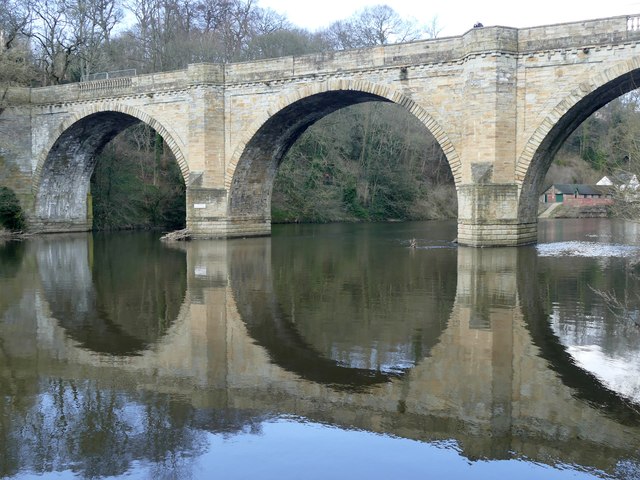Prebends Bridge, Durham, Durham, England

-
Description
Part of the UNESCO World Heritage Site. "Prebends Bridge, along with Framwellgate and Elvet bridges, is one of three stone-arch bridges in the centre of Durham, England, that cross the River Wear. Prebends Bridge was designed by George Nicholson and built from 1772 to 1778. The bridge was built on the instructions of the Dean of Durham and served as a private road for the Dean and Chapter of Durham, giving access from the south through the Watergate. It replaced a temporary bridge built after the footbridge, built in 1574, was swept away during a flood in 1771. The current bridge affords an excellent view of the cathedral and was built specifically with aesthetic considerations in mind - it was built slightly north of the prior bridge, at a wider part of the river, to improve the views available. Trees were planted along the riverbank to complete the Romantic picture. Forming part of the estate of Durham Cathedral, the bridge is a Grade 1 listed building and is situated below the Watergate at the end of South Bailey (with which it is in concurrence), just after St Cuthbert's Society. Although the bridge is wide enough for vehicles, it is mainly used as a footbridge as it only leads to the Riverside paths and up to a closed road barrier to South Bailey. The bridge was restored from 1955 to 1956. In autumn 2010 the bridge was temporarily reopened to road traffic under 3 tonnes while Saddler Street was closed because of extensive repaving works as part of the Heart of the City project, sponsored by Durham City Vision. Durham (/ˈdʌrəm/, locally /ˈdɜrəm/) is a cathedral city and the county town of County Durham in North East England. The city lies on the River Wear, to the south-west of Sunderland, south of Newcastle upon Tyne and to the north of Darlington. Founded over the final resting place of St Cuthbert, its Norman cathedral became a centre of pilgrimage in medieval England. The cathedral and adjacent 11th-century castle were designated a World Heritage Site by UNESCO in 1986. The castle has been the home of Durham University since 1832. HM Prison Durham is also located close to the city centre. City of Durham is the name of the civil parish. The name "Durham" comes from the Celtic element "dun", signifying a hill fort, and the Old Norse "holme", which translates to island. The Lord Bishop of Durham takes a Latin variation of the city's name in his official signature, which is signed "N. Dunelm". Some attribute the city's name to the legend of the Dun Cow and the milkmaid who in legend guided the monks of Lindisfarne carrying the body of Saint Cuthbert to the site of the present city in 995 AD. Dun Cow Lane is said to be one of the first streets in Durham, being directly to the east of Durham Cathedral and taking its name from a depiction of the city's founding etched in masonry on the south side of the cathedral. The city has been known by a number of names throughout history. The original Nordic Dun Holm was changed to Duresme by the Normans and was known in Latin as Dunelm. The modern form Durham came into use later in the city's history. The north-eastern historian Robert Surtees chronicled the name changes in his History and Antiquities of the County Palatine of Durham but states that it is an "impossibility" to tell when the city's modern name came into being. Durham is likely to be Gaer Weir in Armes Prydein, derived from Brittonic cajr meaning "an enclosed, defensible site" (c.f. Carlisle; Welsh caer) and the river-name Wear." - info from Wikipedia. Summer 2019 I did a solo cycling tour across Europe through 12 countries over the course of 3 months. I began my adventure in Edinburgh, Scotland and finished in Florence, Italy cycling 8,816 km. During my trip I took 47,000 photos. Now on https://www.instagram.com/billyd.wilson/" rel="noreferrer nofollow">Instagram. Become a patron to my photography on https://www.patreon.com/billywilson" rel="noreferrer nofollow">Patreon. -
Owner
Billy Wilson Photography -
Source
Flickr (Flickr) -
License
What does this mean? Attribution-NonCommercial License
-
Further information
Link: https://www.flickr.com/photos/32132568@N06/49965253633/
Resource type: Image
Added by: Simon Cotterill
Last modified: 1 year ago
Viewed: 1370 times
Picture Taken: 2019-05-20T07:12:32 -
Co-Curate tags



